Tuesday, December 28, 2021
"Redgrave proceeded to focus on the end of Blue Nights ,
and Didion’s determination to maintain momentum after
the death of Quintana, when she and Redgrave mounted
their production of The Year of Magical Thinking . Here,
St John the Divine became a setting in the narrative of
Blue Nights yet again – this time, as Quintana’s final resting
place in St Ansgar’s Chapel within the cathedral."
The feast of St. Ansgar is Feb. 3. See that date this year.
Related song lyric from "Finian's Rainbow" —
Necessity,
That's the maximum that a minimum thing could be,
There's nothing lower than less unless it's Necessity.
Comments Off on The Redgrave Pill
Thursday, August 12, 2021
|
Filed under: General, Geometry —
Tags: Plato in China, The Church in Philadelphia —
m759 @ 12:00 PM
Women's History Month continues…
Ontology Alignment
"He had with him a small red book of Mao's poems, and as he talked he squared it on the table, aligned it with the table edge first vertically and then horizontally. To understand who Michael Laski is you must have a feeling for that kind of compulsion."
— Joan Didion in the Saturday Evening Post,
Nov. 18, 1967 (reprinted in Slouching Towards Bethlehem)
"Or were you," I said.
He said nothing.
"Raised a Catholic," I said.
He aligned a square crystal paperweight with the edge of his desk blotter.
— Joan Didion in The Last Thing He Wanted, Knopf, 1996
"It was Plato who best expressed– who veritably embodied– the tension between the narrative arts and mathematics….
Plato clearly loved them both, both mathematics and poetry. But he approved of mathematics, and heartily, if conflictedly, disapproved of poetry. Engraved above the entrance to his Academy, the first European university, was the admonition: Oudeis ageometretos eiseto. Let none ignorant of geometry enter. This is an expression of high approval indeed, and the symbolism could not have been more perfect, since mathematics was, for Plato, the very gateway for all future knowledge. Mathematics ushers one into the realm of abstraction and universality, grasped only through pure reason. Mathematics is the threshold we cross to pass into the ideal, the truly real."
— Rebecca Goldstein,
Mathematics and the Character of Tragedy
|
Comments Off on A Square Crystal Paperweight
Friday, July 2, 2021
The above title is from Wallace Stevens.
Related meditations — This journal on March 9, 2021, and . . .

See as well recent posts in this journal
now tagged The Chinese Room Experiment.
For the source of the above Wallace Stevens phrase, see (for instance) . . .

The above weblog post on Stevens is dated November 17, 2010.
Posts in this weblog on that same date and its eve are now tagged . . .
The Horcrux Narrative.
Related Scholarly Remarks:

Comments Off on The Motive for Metaphor
Monday, June 28, 2021
From the Wikipedia Manual of Style —
|
Writing About Fiction . . .
An in-universe perspective describes the narrative
(or a fictional element of the narrative, such as
characters, places, groups, and lore) from the
vantage of characters within the fictional universe,
treating it as if it were real and ignoring
real-world context and sourced analysis.
Many fan wikis and fan websites (see below) take this
approach, but it should not be used for Wikipedia articles.
|
Scholium:

Related art:

Comments Off on Perspective
Thursday, February 25, 2021
“… What is your dream—your ideal? What is your News from Nowhere,
or, rather, What is the result of the little shake your hand has given to
the old pasteboard toy with a dozen bits of colored glass for contents?
And, most important of all, can you present it in a narrative or romance
which will enable me to pass an idle hour not disagreeably? How, for instance,
does it compare in this respect with other prophetic books on the shelf?”
— Hudson, W. H.. A Crystal Age (p. 2). Open Road Media. Kindle Edition.



See as well . . .
The lexicographic Golay code
contains, embedded within it,
the Miracle Octad Generator.
Comments Off on Compare and Contrast
Saturday, February 20, 2021
Epigraph from Google —


Related narratives — the recent film Fast Color * and
a not-so-recent** film . . .

* “Parents need to know that Fast Color is a sci-fi drama
about a family of women who have the ability to deconstruct
objects with their minds.”
** See the not-so-recent writer.
Comments Off on Storm News
Sunday, January 24, 2021

| “… the walkway between here and there would be colder than a witch’s belt buckle. Or a well-digger’s tit. Or whatever the saying was. Vera had been hanging by a thread for a week now, comatose, in and out of Cheyne-Stokes respiration, and this was exactly the sort of night the frail ones picked to go out on. Usually at 4 a.m. He checked his watch. Only 3:20, but that was close enough for government work.”
— King, Stephen (2013-09-24).
Doctor Sleep: A Novel (p. 133). Scribner. Kindle Edition. |
Related narrative — November 13, 2014.
Comments Off on Sunday in the Park with the Welldigger
Friday, January 15, 2021
Reflection in the door of 794 Lexington Avenue,
New York City, November 2019 —

The object reflected —

To enlarge the image, click the above view of Lexington Ave. traffic.
Related narratives —
The life stories of “Germany’s oldest bookseller,” who reportedly died
around New Year’s 2021, and of her uncle, who had an art-book store
and gallery at 794 Lexington Avenue starting in 1923.
Comments Off on Reflection for a Forked Tongue
Saturday, January 9, 2021
“In a sense, we would see that change arises from
the structure of the object.”
— Nima Arkani-Hamed, quoted in
“A Jewel at the Heart of Quantum Physics,”
by Natalie Wolchover, Quanta Magazine , Sept. 17, 2013.

For those who prefer less barbaric entertainment —

Comments Off on A Sense
Thursday, January 7, 2021
From a post of Tuesday, May 7, 2019 —
Breach
“Honored in the Breach:
Graham Bader on Absence as Memorial”
Artforum International , April 2012
| . . . .
“In the wake of a century marked by inconceivable atrocity, the use of emptiness as a commemorative trope has arguably become a standard tactic, a default style of public memory. The power of the voids at and around Ground Zero is generated by their origin in real historical circumstance rather than such purely commemorative intent: They are indices as well as icons of the losses they mark.
Nowhere is the negotiation between these two possibilities–on the one hand, the co-optation of absence as tasteful mnemonic trope; on the other, absence’s disruptive potential as brute historical scar–more evident than in Berlin, a city whose history, as Andreas Huyssen has argued, can be seen as a ‘narrative of voids.’ Writing in 1997, Huyssen saw this tale culminating in Berlin’s post-wall development, defined equally by an obsessive covering-over of the city’s lacunae–above all in the elaborate commercial projects then proliferating in the miles-long stretch occupied until 1989 by the Berlin Wall–and a carefully orchestrated deployment of absence as memorial device, particularly in the ‘voids’ integrated by architect Daniel Libeskind into his addition to the Berlin Museum, now known as the Jewish Museum Berlin.”
. . . . |
See also Breach in this journal, as well as Void.
* Literary background — The word “Purloined” in this journal.
Comments Off on The Purloined* Void
Thursday, October 29, 2020
The service hosting my Log24 images is down. I do not know
when it will be up again.*
Meanwhile, a WordPress Media workaround image —
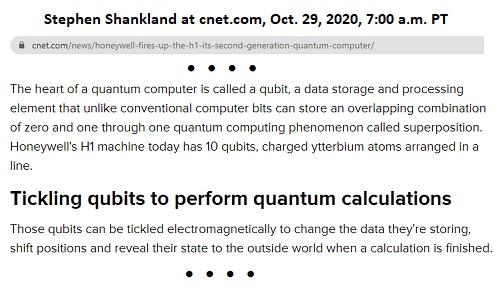
Related narrative for a Code Girl —
“Tickle: Change, Shift, Reveal.”
* Update at 5 AM Oct. 30: Images are back.
To celebrate their return . . . .
“Dance Practice Video,” still and detail.
Comments Off on Images in posts are down.
Friday, October 23, 2020
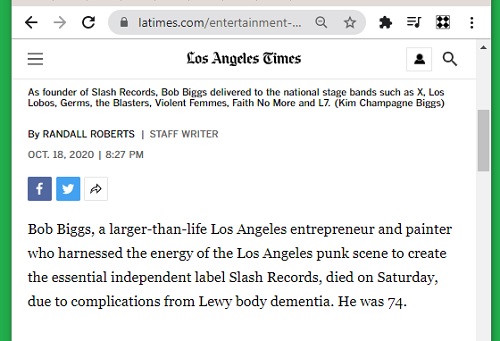
Midrash for the late Harold Bloom,
author of The Daemon Knows —
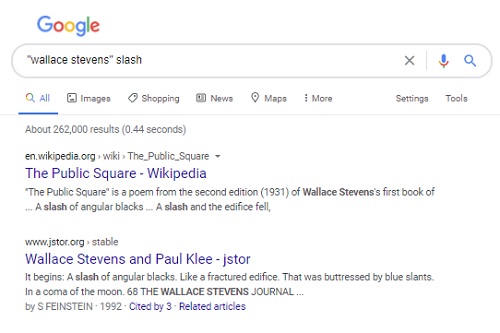
It is perhaps not irrelevant that the phrase "on Saturday" in the
Los Angeles Times of Sunday, October 18, 2020, refers to the
preceding day — October 17, 2020. See too that date here.
Related material —

— November 2020
Notices of the American Mathematical Society
For fans of mathematics and narrative —
Some may fancy Bloom as a dybbuk (cf, "A Serious Man") turning
the page in the article above to the next page, 1590 —


Comments Off on News from Saint Luke’s Day
Sunday, September 27, 2020
Comments Off on Entertainment News
Sunday, August 2, 2020
A post of May 26, 2005, displays, if not the sword,
a place for it —
Drama of the Diagonal
"The beautiful in mathematics resides in contradiction.
Incommensurability, logoi alogoi, was the first splendor
in mathematics." — Simone Weil, Oeuvres Choisies,
éd. Quarto , Gallimard, 1999, p. 100

Logos Alogos by S. H. Cullinane
"To a mathematician, mathematical entities have their own existence,
they habitate spaces created by their intention. They do things,
things happen to them, they relate to one another. We can imagine
on their behalf all sorts of stories, providing they don't contradict
what we know of them. The drama of the diagonal, of the square…"
— Dennis Guedj, abstract of "The Drama of Mathematics," a talk
to be given this July at the Mykonos conference on mathematics and
narrative. For the drama of the diagonal of the square, see
Comments Off on The Sword and the Stone
Monday, May 4, 2020
The title is a phrase from the Suzanne Vega song in the previous post.
“Always busy counting . . . .” — Tagline at Peter J. Cameron’s weblog.
“This morning brought the news that Jan Saxl died on Saturday.”
— Peter J. Cameron today
A search for Saxl in this weblog yields a post related to a topic in
Wolfram Neutsch’s book Coordinates. See Saturday’s post
“Turyn’s Octad Theorem: The Next Level.”
Related narrative from the Saturday post —

Related narrative from Sunday’s Westworld finale —

Comments Off on The Man Behind the Counter
Sunday, February 2, 2020

Prominent in the oeuvre of art theorist Rosalind Krauss, the Klein group
is a four-element group named for Felix Christian Klein.
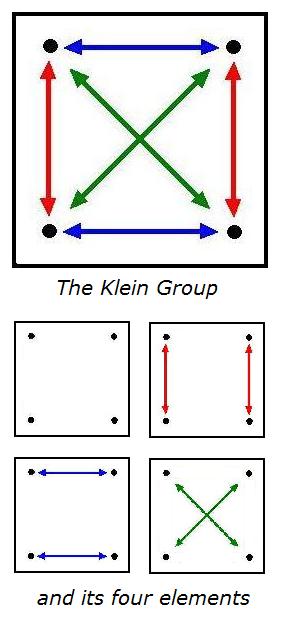
It is commonly known as the four-group.
Mathematicians sometimes call this group
"V," for its German name, Vierergruppe .
For those who prefer narrative to mathematics —

Comments Off on “Krauss, Portman; Portman, Krauss.”
Tuesday, January 28, 2020
Two of the thumbnail previews
from yesterday's 1 AM post …
"Hum a few bars"

"For 6 Prescott Street"

Further down in the "6 Prescott St." post, the link 5 Divinity Avenue
leads to …
|
A Letter from Timothy Leary, Ph.D., July 17, 1961
Harvard University
Department of Social Relations
Center for Research in Personality
Morton Prince House
5 Divinity Avenue
Cambridge 38, Massachusetts
July 17, 1961
Dr. Thomas S. Szasz
c/o Upstate Medical School
Irving Avenue
Syracuse 10, New York
Dear Dr. Szasz:
Your book arrived several days ago. I've spent eight hours on it and realize the task (and joy) of reading it has just begun.
The Myth of Mental Illness is the most important book in the history of psychiatry.
I know it is rash and premature to make this earlier judgment. I reserve the right later to revise and perhaps suggest it is the most important book published in the twentieth century.
It is great in so many ways–scholarship, clinical insight, political savvy, common sense, historical sweep, human concern– and most of all for its compassionate, shattering honesty.
. . . .
|
The small Morton Prince House in the above letter might, according to
the above-quoted remarks by Corinna S. Rohse, be called a "jewel box."
Harvard moved it in 1978 from Divinity Avenue to its current location at
6 Prescott Street.
Related "jewel box" material for those who
prefer narrative to mathematics —
"In The Electric Kool-Aid Acid Test , Tom Wolfe writes about encountering
'a young psychologist,' 'Clifton Fadiman’s nephew, it turned out,' in the
waiting room of the San Mateo County jail. Fadiman and his wife were
'happily stuffing three I-Ching coins into some interminable dense volume*
of Oriental mysticism' that they planned to give Ken Kesey, the Prankster-
in-Chief whom the FBI had just nabbed after eight months on the lam.
Wolfe had been granted an interview with Kesey, and they wanted him to
tell their friend about the hidden coins. During this difficult time, they
explained, Kesey needed oracular advice."
— Tim Doody in The Morning News web 'zine on July 26, 2012**
Oracular advice related to yesterday evening's
"jewel box" post …
A 4-dimensional hypercube H (a tesseract ) has 24 square
2-dimensional faces. In its incarnation as a Galois tesseract
(a 4×4 square array of points for which the appropriate transformations
are those of the affine 4-space over the finite (i.e., Galois) two-element
field GF(2)), the 24 faces transform into 140 4-point "facets." The Galois
version of H has a group of 322,560 automorphisms. Therefore, by the
orbit-stabilizer theorem, each of the 140 facets of the Galois version has
a stabilizer group of 2,304 affine transformations.
Similar remarks apply to the I Ching In its incarnation as
a Galois hexaract , for which the symmetry group — the group of
affine transformations of the 6-dimensional affine space over GF(2) —
has not 322,560 elements, but rather 1,290,157,424,640.
* The volume Wolfe mentions was, according to Fadiman, the I Ching.
** See also this journal on that date — July 26, 2012.
Comments Off on Very Stable Kool-Aid
Friday, January 24, 2020


Related material —
"Off Broadway," a post from the date
of Eric James's death.
Comments Off on Exploring Fiction
Friday, October 11, 2019
John Horgan in Scientific American magazine on October 8, 2019 —
"In the early 1990s, I came to suspect that the quest
for a unified theory is religious rather than scientific.
Physicists want to show that all things came from
one thing: a force, or essence, or membrane
wriggling in eleven dimensions, or something that
manifests perfect mathematical symmetry. In their
search for this primordial symmetry, however,
physicists have gone off the deep end . . . ."
Other approaches —
See "Story Theory of Truth" in this journal and, from the November 2019
Notices of the American Mathematical Society . . .
|
Story Driven
More fundamental than the label of mathematician is that of human. And as humans, we’re hardwired to use stories to make sense of our world (story-receivers) and to share that understanding with others (storytellers) [2]. Thus, the framing of any communication answers the key question, what is the story we wish to share? Mathematics papers are not just collections of truths but narratives woven together, each participating in and adding to the great story of mathematics itself.
The first endeavor for constructing a good talk is recognizing and choosing just one storyline, tailoring it to the audience at hand. Should the focus be on a result about the underlying structures of group actions? . . . .
[2] Gottschall, J. , The Storytelling Animal ,
Houghton Mifflin Harcourt, 2012.
— "Giving Good Talks," by Satyan L. Devadoss
|
"Before time began, there was the Cube." — Optimus Prime
Comments Off on Quest
Wednesday, October 9, 2019
Note that in the pictures below of the 15 two-subsets of a six-set,
the symbols 1 through 6 in Hudson's square array of 1905 occupy the
same positions as the anticommuting Dirac matrices in Arfken's 1985
square array. Similarly occupying these positions are the skew lines
within a generalized quadrangle (a line complex) inside PG(3,2).



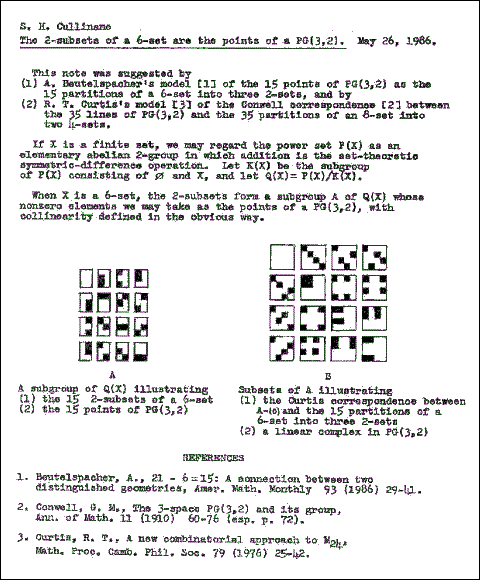
Related narrative — The "Quantum Tesseract Theorem."
Comments Off on The Joy of Six
Saturday, September 21, 2019
See other posts now tagged Six Dots.
Related narrative: Raiders of the Lost Ring .
Comments Off on Six Dots
Monday, September 2, 2019
A link, observablehq.com/demo, (not functioning in my Chrome
browser at the present time but apparently OK in Firefox) in the
previous post suggests . . .
"Physically meaningful observables must also satisfy
transformation laws which relate observations
performed by different observers in different
frames of reference. These transformation laws are
automorphisms of the state space, that is
bijective transformations which preserve certain
mathematical properties of the space in question."
— Wikipedia, Observable
Those who prefer narrative to mathematics may read
"automorphisms" as "auto morphisms."
"Before time began . . . ." — "Transformers" first line, 2007
Comments Off on Observables
Wednesday, July 24, 2019
"Games provide frameworks that miniaturize
and represent idealized realities; so do narratives."
— Adam Rogers, Sunday, July 21, 2019, at Wired
Reviewing yesterday's post Word Magic —

See also a technological framework (the microwave at left) vs. a
purely mathematical framework (the pattern on the towel at right)
in the image below:

For some backstory about the purely mathematical framework,
see Octad Generator in this journal.
Comments Off on Frameworks
Tuesday, July 23, 2019
"Business-wise, Magic is working—Bloomberg reported
that the game brought in $500 million in revenue last year.
Hasbro owns Monopoly and Scrabble, but Magic is its top
game brand. . . .
The idea of using a card mechanic to generate story has
precedent—the Italian postmodern writer Italo Calvino
generated an entire novel based on drawing from a
tarot card deck. Games provide frameworks that miniaturize
and represent idealized realities; so do narratives."
— Adam Rogers, Sunday, July 21, 2019, at Wired

"The Esper party began . . ." —
|
Life of the Party
From Stephen King's Dreamcatcher :

From Alfred Bester's The Demolished Man :

From Anne McCaffrey's To Ride Pegasus :
"… it's going to be accomplished in steps, this
establishment of the Talented in the scheme of things."
|
Adam Rogers at Wired as quoted above —
"The idea of using a card mechanic to generate story
has precedent. . . ."
See The Greater Trumps .
Comments Off on Word Magic
Tuesday, May 7, 2019
"Honored in the Breach:
Graham Bader on Absence as Memorial"
Artforum International , April 2012
|
. . . .
"In the wake of a century marked by inconceivable atrocity, the use of emptiness as a commemorative trope has arguably become a standard tactic, a default style of public memory. The power of the voids at and around Ground Zero is generated by their origin in real historical circumstance rather than such purely commemorative intent: They are indices as well as icons of the losses they mark.
Nowhere is the negotiation between these two possibilities–on the one hand, the co-optation of absence as tasteful mnemonic trope; on the other, absence's disruptive potential as brute historical scar–more evident than in Berlin, a city whose history, as Andreas Huyssen has argued, can be seen as a 'narrative of voids.' Writing in 1997, Huyssen saw this tale culminating in Berlin's post-wall development, defined equally by an obsessive covering-over of the city's lacunae–above all in the elaborate commercial projects then proliferating in the miles-long stretch occupied until 1989 by the Berlin Wall–and a carefully orchestrated deployment of absence as memorial device, particularly in the 'voids' integrated by architect Daniel Libeskind into his addition to the Berlin Museum, now known as the Jewish Museum Berlin."
. . . .
|
See also Breach in this journal.
Comments Off on Breach
Friday, May 3, 2019
T. S. Eliot —
Four Quartets
. . . Only by the form, the pattern,
Can words or music reach
The stillness, as a Chinese jar still
Moves perpetually in its stillness.
Lévi-Strauss —
A Permanent Order of Wondertale Elements
| In Vol. I of Structural Anthropology , p. 209, I have shown that this analysis alone can account for the double aspect of time representation in all mythical systems: the narrative is both “in time” (it consists of a succession of events) and “beyond” (its value is permanent). With regard to Propp’s theories my analysis offers another advantage: I can reconcile much better than Propp himself his principle of a permanent order of wondertale elements with the fact that certain functions or groups of functions are shifted from one tale to the next (pp. 97-98. p. 108). If my view is accepted, the chronological succession will come to be absorbed into an atemporal matrix structure whose form is indeed constant. The shifting of functions is then no more than a mode of permutation (by vertical columns or fractions of columns). |
… Or by congruent quarter-sections.
Comments Off on The Structure of Story Space
Friday, March 22, 2019
"The stars and galaxies seem static, eternal, or moving slowly
in deterministic patterns, becoming the background stage
on which we move. But if we could speed up the sequence,
we would see how dramatic and unpredictable this background
really is — an actor, director, script and stage all at once.
Moreover, it is a unified universe, a single unfolding event
of which we are an embedded part, a narrative of highly
dangerous and fine-tuned events, something more like
a detective thriller with many crimes and last-minute escapes
than the impersonal account of astronomy textbooks.
We are only just beginning to decipher the plot and figure out
the Cosmic Code, as Heinz Pagels puts it."
— Charles Jencks, The Architecture of the Jumping Universe :
A Polemic (How Complexity Science is Changing Architecture
and Culture), Academy Editions, 1995, rev. ed. 1997
"A Grand Unified Theory (GUT) is a model in particle physics…."
— Wikipedia
"Under the GUT symmetry operation these field components
transform into one another. The reason quantum particles
appear to have different properties in nature is that the unifying
symmetry is broken. The various gluons, quarks and leptons
are analogous to the facets of a cut diamond, which appear
differently according to the way the diamond is held but in
fact are all manifestations of the same underlying object."
— Heinz Pagels, Perfect Symmetry , Bantam paperback, 1986, p. 284
See also the recent post Multifaceted Narrative.
Comments Off on Charles Jencks’s Grand Unified Theory
Friday, January 11, 2019

See also yesterday’s Archimedes at Hiroshima and the
above 24 graphic permutations on All Souls’ Day 2010.
For some backstory, see Narrative Line (November 10, 2014).
Comments Off on Permutations at Oslo
Saturday, December 29, 2018
The title is that of a 1977 poem by Jon Lang.
A different sort of narrative tree, from The Onion on the
date Friday, July 1, 2016, was illustrated in the previous post.
Material from this journal related to July 1, 2016,
and the following day, a Saturday, is now tagged
"Saturday Night in the Labyrinth."

"A Damned Serious Business." — Rex Harrison on comedy
Comments Off on Winter Tree
Wednesday, December 26, 2018
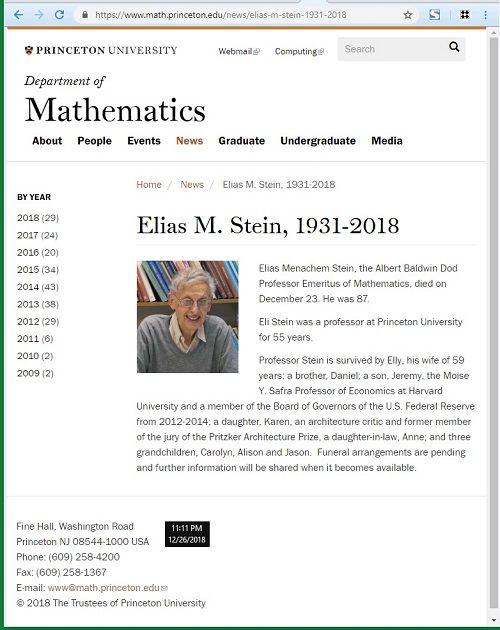
See as well Stein in posts tagged Narrative Labyrinth.
Comments Off on Mathematical Labyrinth
Saturday, November 17, 2018

See as well . . .

. . . and posts tagged Alperin.
On its current homepage, the American Mathematical Society
links to a Nov. 15 blog post illustrating the Stan Lee approach
to mathematics:
Stories: "Math needs more stories. All kinds of stories…" —

See too Mathematics and Narrative in this journal.
Comments Off on Representation
Friday, September 7, 2018
From a search in this journal for "Public Square" —
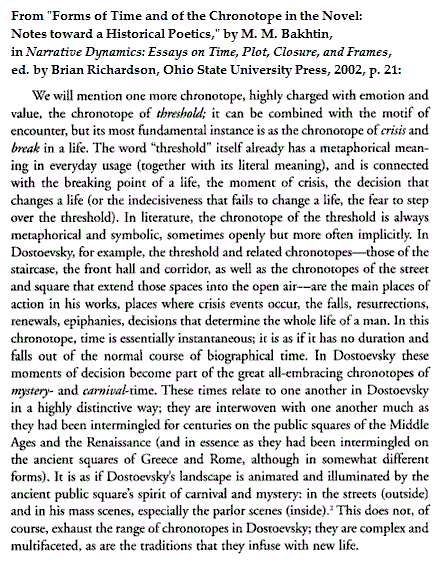
See also Gresham in this journal.
Comments Off on Carnival and Mystery
Wednesday, September 5, 2018
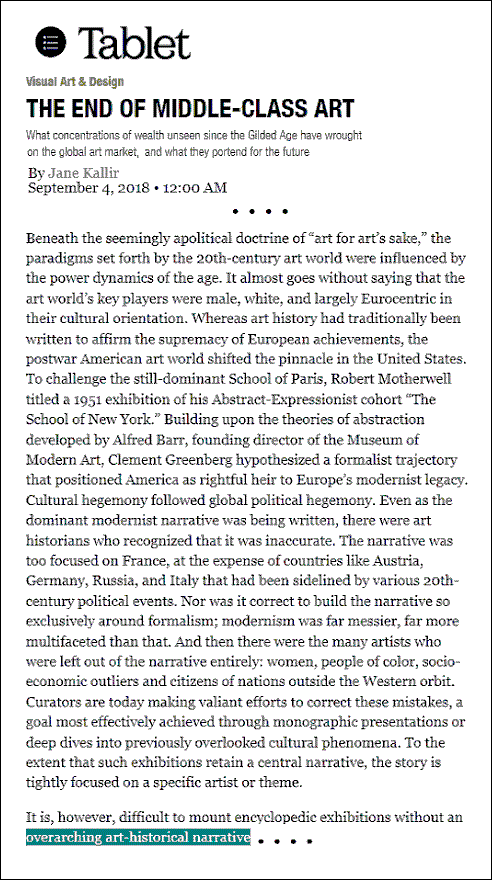
See also 12 AM Sept. 4 in this journal, "Identity Crisis."
Related material — "Overarching" in this journal.
Update of 4:12 AM ET —
The name of the New Yorker artist in the Identity Crisis post,
Tamara Shopsin, has now been added to the illustrated excerpt.
See as well . . .
https://www.nytimes.com/2018/09/04/obituaries/
kenny-shopsin-dead.html.
itemprop="datePublished"
content="2018-09-04T22:17:59.000Z"
Comments Off on Midnight Art
Tuesday, August 7, 2018
Smartphone Meets Laptop —

Some related narrative from the previous post —
“All right, Jessshica. It’s time to open the boxsssschhh.”
Comments Off on Annals of E-Romance:
Thursday, July 19, 2018

A search for the phrase "nonlinear Boolean algebra" yields few results.
"Nonlinear Boolean functions " seems to be the phrase intended.
On the mathematics of nonlinear Boolean functions —


A memorable death —

For those who prefer narrative to mathematics —

A related image —

Comments Off on The Corrections (Continued)
Monday, July 16, 2018

"The novel has a parallel narrative that eventually
converges with the main story."
— Wikipedia on a book by Foer's novelist brother
Public Squares
An image from the online New York Times
on the date, July 6,
of the above Atlantic article —

An image from "Blackboard Jungle," 1955 —

"Through the unknown, remembered gate . . . ."
— T. S. Eliot, Four Quartets
Comments Off on Greatly Exaggerated Report
Thursday, July 5, 2018
Some context for what Heidegger called
das Spiegel-Spiel des Gevierts
From Helen Lane's translation of El Mono Gramático ,
a book by Nobel winner Octavio Paz first published
in Barcelona by Seix Barral in 1974 —
|
Simultaneous perspective does not look upon language as a path because it is not the search for meaning that orients it. Poetry does not attempt to discover what there is at the end of the road; it conceives of the text as a series of transparent strata within which the various parts—the different verbal and semantic currents—produce momentary configurations as they intertwine or break apart, as they reflect each other or efface each other. Poetry contemplates itself, fuses with itself, and obliterates itself in the crystallizations of language. Apparitions, metamorphoses, volatilizations, precipitations of presences. These configurations are crystallized time: although they are perpetually in motion, they always point to the same hour—the hour of change. Each one of them contains all the others, each one is inside the others: change is only the oft-repeated and ever-different metaphor of identity.
— Paz, Octavio. The Monkey Grammarian
(Kindle Locations 1185-1191).
Arcade Publishing. Kindle Edition.
|
A related 1960 meditation from Claude Lévi-Strauss taken from a
Log24 post of St. Andrew's Day 2017, "The Matrix for Quantum Mystics":
The Matrix of Lévi-Strauss —

"In Vol. I of Structural Anthropology , p. 209, I have shown that
this analysis alone can account for the double aspect of time
representation in all mythical systems: the narrative is both
'in time' (it consists of a succession of events) and 'beyond'
(its value is permanent)." — Claude Lévi-Strauss
I prefer the earlier, better-known, remarks on time by T. S. Eliot
in Four Quartets , and the following four quartets
(from The Matrix Meets the Grid) —
 .
.
Comments Off on Paz:
Friday, June 1, 2018
From a 2003 obituary of author Neil Postman —
"In Amusing Ourselves to Death: Public Discourse
in the Age of Show Business (Viking, 1985; Penguin, 1986),
he indicted the television industry on the charge of making
entertainment out of the world's most serious problems.
The book was translated into eight languages and sold
200,000 copies worldwide, according to N.Y.U."
Postman reportedly died on Sunday, Oct. 5, 2003.
Log24 on that date —
Art Theory for Yom Kippur and Ado.
See also today's obituary reporting the May 21 death of Postman's
erstwhile agent Elaine Markson.
This journal on May 21, in a post titled "Crux" —
"Chance became tied to the liberties
of U.S. democracy, whereas its eradication
or denial became symptomatic of Soviet tyranny."
— Google Books description of No Accident, Comrade:
Chance and Design in Cold War American Narrative,
by Steven Belletto, Oxford U. Press (first published
in hardcover on Dec. 28, 2011)
Midrash —

Click the image for related posts.
Comments Off on The Agent
Friday, May 11, 2018

See as well other posts tagged Modernism.
Comments Off on On this date 19 years ago…
Sunday, January 21, 2018
"In 'Sophistry,' a new play by Jonathan Marc Sherman
at the Playwrights Horizons Studio, a popular tenured
professor stands accused of sexual harassment
by a male student."
— Frank Rich in The New York Times , theater review
on October 12, 1993
"At which point another play, inchoate but arresting,
edges into view." — Rich, ibid.
"Johansson began acting during childhood,
after her mother started taking her to auditions.
She made her professional acting debut
at the age of eight in the off-Broadway production
of 'Sophistry' with Ethan Hawke, at New York's
Playwrights Horizons."
— IMDb Mini Biography by: Pedro Borges
" 'Suddenly, I was 19 again and I started to remember
all the men I'd known who had taken advantage of
the fact that I was a young woman who didn't yet have
the tools to say no, or to understand the value of
my own self-worth,' the Avengers star described.
'I had many relationships both personal and professional
where the power dynamic was so off that I had to create
a narrative in which I was the cool girl who could hang in
and hang out, and that sometimes meant compromising
what felt right for me . . . . ' "
— Scarlett Johansson yesterday at the 2018 Women's March
in Los Angeles, as reported in E! News .

Image in a Log24 post
of March 12, 2009.
Comments Off on At Which Point
Saturday, December 23, 2017
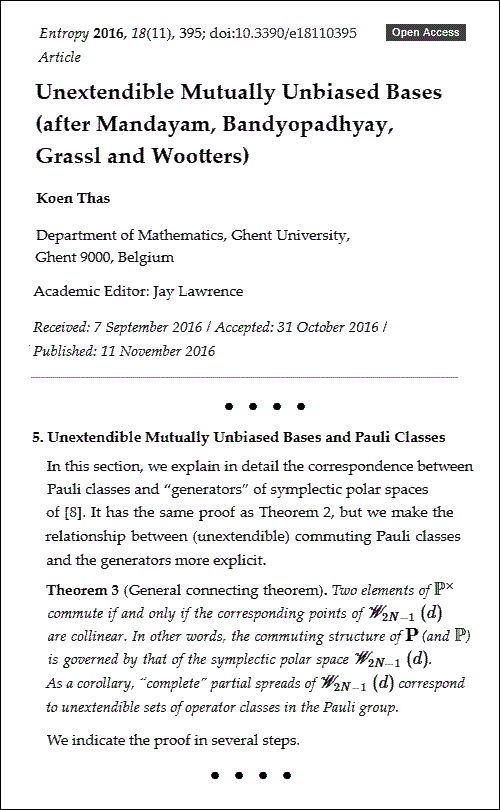
A figure related to the general connecting theorem of Koen Thas —


See also posts tagged Dirac and Geometry in this journal.
Those who prefer narrative to mathematics may, if they so fancy, call
the above Thas connecting theorem a "quantum tesseract theorem ."
Comments Off on The Right Stuff
Thursday, November 30, 2017
Scholia on the title — See Quantum + Mystic in this journal.

The Matrix of Lévi-Strauss —

"In Vol. I of Structural Anthropology , p. 209, I have shown that
this analysis alone can account for the double aspect of time
representation in all mythical systems: the narrative is both
'in time' (it consists of a succession of events) and 'beyond'
(its value is permanent)." — Claude Lévi-Strauss, 1976
I prefer the earlier, better-known, remarks on time by T. S. Eliot
in Four Quartets , and the following four quartets (from
The Matrix Meets the Grid) —
 .
.
From a Log24 post of June 26-27, 2017:
A work of Eddington cited in 1974 by von Franz —

See also Dirac and Geometry and Kummer in this journal.
Ron Shaw on Eddington's triads "associated in conjugate pairs" —

For more about hyperbolic and isotropic lines in PG(3,2),
see posts tagged Diamond Theorem Correlation.

For Shaw, in memoriam — See Contrapuntal Interweaving and The Fugue.
Comments Off on The Matrix for Quantum Mystics
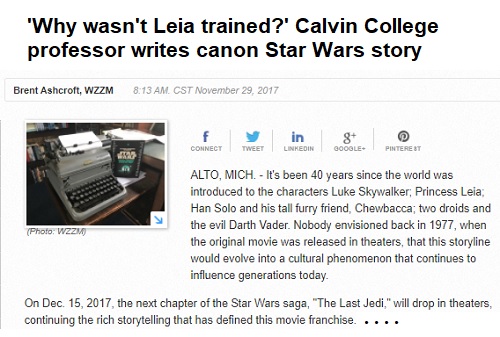

For those who prefer mathematics to narrative —


Comments Off on Typewriter Wars
Thursday, November 23, 2017
David Brooks in The New York Times today —
"We once had a unifying national story, celebrated each Thanksgiving.
It was an Exodus story. Americans are the people who escaped oppression,
crossed a wilderness and are building a promised land. The Puritans brought
this story with them. Each wave of immigrants saw themselves in this story.
The civil rights movement embraced this story.
But we have to admit that many today do not resonate with this story. . . .
Today, we have no common national narrative, no shared way
of interpreting the flow of events. Without a common story,
we don’t know what our national purpose is. We have no
common set of goals or ideals.
We need a new national narrative."
From a post of August 15, 2010 —

For some background, see Java Jive and Today's Theology.
Related readings —
From 1928:

From the previous post:
"Thus, instead of Propp's chronological scheme,
in which the order of succession of events
is a feature of the structure . . .
another scheme should be adopted, which would present
a structural model defined as the group of transformations
of a small number of elements. This scheme would appear
as a matrix . . . ."
— Claude Lévi-Strauss, 1960

Comments Off on The Matrix
| Claude Lévi-Strauss
From his “Structure and Form:
Reflections on a Work by Vladimir Propp” *
To maintain. as I have done. that the permutability of contents is not arbitrary amounts to saying that, if the analysis is carried to a sufficiently deep level, behind diversity we will discover constancy. And, of course. the avowed constancy of form must not hide from us that functions are also permutable.
The structure of the folktale as it is illustrated by Propp presents a chronological succession of qualitatively distinct functions. each constituting an independent genre. One can wonder whether—as with dramatis personae and their attributes— Propp does not stop too soon, seeking the form too close to the level of empirical observation. Among the thirty-one functions that he distinguishes, several are reducible to the same function reappearing at different moments of the narrative but after undergoing one or a number of transformations . I have already suggested that this could be true of the false hero (a transformation of the villain), of assigning a difficult task (a transformation of the test), etc. (see p. 181 above), and that in this case the two parties constituting the fundamental tale would themselves be transformations of each other.
Nothing prevents pushing this reduction even further and analyzing each separate partie into a small number of recurrent functions, so that several of Propp’s functions would constitute groups of transformations of one and the same function. We could treat the “violation” as the reverse of the “prohibition” and the latter as a negative transformation of the “injunction.” The “departure” of the hero and his “return” would appear as the negative and positive expressions of the same disjunctive function. The “quest” of the hero (hero pursues someone or something) would become the opposite of “pursuit” (hero is pursued by something or someone), etc.

In Vol. I of Structural Anthropology , p. 209, I have shown that this analysis alone can account for the double aspect of time representation in all mythical systems: the narrative is both “in time” (it consists of a succession of events) and “beyond” (its value is permanent). With regard to Propp’s theories my analysis offers another advantage: I can reconcile much better than Propp himself his principle of a permanent order of wondertale elements with the fact that certain functions or groups of functions are shifted from one tale to the next (pp. 97-98. p. 108) If my view is accepted, the chronological succession will come to be absorbed into an atemporal matrix structure whose form is indeed constant. The shifting of functions is then no more than a mode of permutation (by vertical columns or fractions of columns).
These critical remarks are certainly valid for the method used by Propp and for his conclusions. However. it cannot be stressed enough that Propp envisioned them and in several places formulated with perfect clarity the solutions I have just suggested. Let us take up again from this viewpoint the two essential themes of our discussion: constancy of the content (in spite of its permutability) and permutability of functions (in spite of their constancy).
* Translated from a 1960 work in French. It appeared in English as Chapter VIII
of Structural Anthropology, Volume 2 (U. of Chicago Press, 1976). Chapter VIII
was originally published in Cahiers de l’Institut de Science Économique Appliquée ,
No. 9 (Series M, No. 7) (Paris: ISEA, March 1960).
|
See also “Lévi-Strauss” + Formula in this journal.
Some background related to the previous post —

Comments Off on Lévi-Strauss vs. Propp
Thursday, August 3, 2017
Or: Trinity Test Site

From the New York Times Book Review of
next Sunday, August 6, 2017 —
"In a more conventional narrative sequence,
even a sequence of poems,
this interpenetration would acquire
sequence and evolution." [Link added.]
The concept under review is that of the Holy Trinity.
See also, in this journal, Cube Trinity.
For a simpler Trinity model, see the three-point line …

Comments Off on Poetic Theology at the New York Times
Wednesday, July 5, 2017
"The heart of the doctor's show is a magic mirror that allows
those who go through it to experience another dimension of
their own minds. Once inside, people choose for good or evil,
opting for — to give one example — either the difficult but
rewarding heights of Mt. Parnassus or the easy pleasures of
Mr. Nick's Lounge Bar. As the doctor angrily puts it when asked
what he's playing at, 'We don't play, what we do is deadly serious,'
which means nothing less than the eternal battle with the devil
for the spirit of man."
— Kenneth Turan, Los Angeles Times film critic, Christmas Day 2009,
reviewing "The Imaginarium of Doctor Parnassus."
In terms that might interest the late museum director of the previous post …
Quoted here from The New Criterion on June 2, 2017 —

Quoted here from The New York Times on June 1, 2017 —
MoMA’s Makeover Rethinks the Presentation of Art
"The new design calls for more gallery space and a transformed
main lobby, physical changes that, along with the re-examination
of art collections and diversity, represent an effort to open up MoMA
and break down the boundaries defined by its founder, Alfred Barr.
'It’s a rethinking of how we were originally conceived,' Glenn D. Lowry,
the museum’s director, said in an interview at MoMA. 'We had created
a narrative for ourselves that didn’t allow for a more expansive reading
of our own collection, to include generously artists from very different
backgrounds.'"
Comments Off on The Imaginarium
Tuesday, June 20, 2017
Continuing the previous post's theme …
Group actions on partitions —

Cube Bricks 1984 —


Related material — Posts now tagged Device Narratives.
Comments Off on Epic
Thursday, June 1, 2017
From The New York Times today —
MoMA’s Makeover Rethinks the Presentation of Art
"The new design calls for more gallery space and a transformed
main lobby, physical changes that, along with the re-examination
of art collections and diversity, represent an effort to open up MoMA
and break down the boundaries defined by its founder, Alfred Barr.
'It’s a rethinking of how we were originally conceived,' Glenn D. Lowry,
the museum’s director, said in an interview at MoMA. 'We had created
a narrative for ourselves that didn’t allow for a more expansive reading
of our own collection, to include generously artists from very different
backgrounds.'"


Comments Off on Art Spaces (For Frank Sinatra and Janet Leigh)
Sunday, March 26, 2017
"Eigenvalues. Fixed points. Stable equilibria.
Mathematicians like things that stay put.
And if they can't stay put, the objects of study
should at least repeat themselves on a regular basis. . . ."
— Barry Cipra, "A Moveable Feast," SIAM News , Jan. 14, 2006
Tuesday, March 18, 2014
Uncategorized — m759 @ 12:00 PM
Mathematician Norbert Wiener reportedly
died on this date in 1964.
“Mathematics is too arduous and uninviting a field
to appeal to those to whom it does not give great rewards.
These rewards are of exactly the same character as
those of the artist. To see a difficult uncompromising material
take living shape and meaning is to be Pygmalion,
whether the material is stone or hard, stonelike logic."
. . . .
Wednesday, March 18, 2015
Uncategorized — m759 @ 1:00 PM
(A saying of Friedrich Fröbel)

. . . .
Friday, March 18, 2016
Uncategorized — m759 @ 2:56 PM
Kyle Smith on April 15, 2015, in the New York Post —
"The ludicrous action thriller 'Beyond the Reach'
fails to achieve the Southwestern noir potency
of 'No Country for Old Men,' but there’s no denying
it brings to mind another Southwestern classic
about malicious pursuit: the Road Runner cartoons."
. . . .
Saturday, March 18, 2017
Uncategorized — Tags: Narrative Labyrinth — m759 @ 7:35 PM
"Old men ought to be explorers" — T. S. Eliot
 . . . . . . . .
|
* For a full four years, see also March 18, 2013.
Comments Off on Four-Year* Date
Friday, March 24, 2017

"Minow is the daughter of former Federal Communications Commission chairman
Newton Minow, and his wife, Josephine (Baskin) Minow. She graduated from
New Trier Township High School in 1972." — Wikipedia
“That corpse you planted last year in your garden,
Has it begun to sprout? Will it bloom this year?
Or has the sudden frost disturbed its bed?"
Comments Off on Note for a Vast Waste Land
Friday, March 17, 2017
(A sequel to the previous post, Narrative for Westworld)
"That corpse you planted last year . . . ." — T. S. Eliot

Circle and Square at the Court of King Minos —

Harmonic analysis based on the circle involves the
circular functions. Dyadic harmonic analysis involves …

For some related history, see (for instance) E. M. Stein
on square functions in a 1982 AMS Bulletin article.
Comments Off on To Coin a Phrase
Thursday, February 23, 2017
Continued.
" The origin of new ways of doing things may often be
a disciplinary crisis. The definition of such a crisis
provided by Barry Mazur in Mykonos (2005) applies
equally well to literary creation. '[A crisis occurs] when
some established overarching framework, theoretical
vocabulary or procedure of thought is perceived as
inadequate in an essential way, or not meaning
what we think it means.' "
— Circles Disturbed :
The Interplay of Mathematics and Narrative
Edited by Apostolos Doxiadis & Barry Mazur
Princeton University Press, 2012. See
Chapter 14, Section 5.1, by Uri Margolin.
See also "overarching" in this journal.
Comments Off on Bullshit Studies
Saturday, January 7, 2017
See Log24 posts of January 7, 2012.
That was the date of death for mathematician Herbert S. Wilf.
For some related narrative, see posts tagged Consciousness Growth.
Comments Off on Five Years Ago
Tuesday, November 22, 2016
See "sacerdotal jargon" in this journal.
For those who prefer scientific jargon —
"… open its reading to
combinational possibilities
outside its larger narrative flow.
The particulars of attention,
whether subjective or objective,
are unshackled through form,
and offered as a relational matrix …."
— Kent Johnson in a 1993 essay
For some science that is not just jargon, see …

and, also from posts tagged Dirac and Geometry …

The above line complex also illustrates an outer automorphism
of the symmetric group S6. See last Thursday's post "Rotman and
the Outer Automorphism."
Comments Off on Jargon
Sunday, October 2, 2016
On a new HBO series that opens at 9 PM ET tonight —

|
Watching Westworld , you can sense a grand mythology unfolding before your eyes. The show’s biggest strength is its world-building, an aspect of screenwriting that many television series have botched before. Often shows will rush viewers into plot, forgetting to instill a sense of place and of history, that you’re watching something that doesn’t just exist in a vacuum but rather is part of some larger ecosystem. Not since Lost can I remember a TV show so committed to immersing its audience into the physical space it inhabits. (Indeed, Westworld can also be viewed as a meta commentary on the art of screenwriting itself: brainstorming narratives, building characters, all for the amusement of other people.)
Westworld is especially impressive because it builds two worlds at once: the Western theme park and the futuristic workplace. The Western half of Westworld might be the more purely entertaining of the two, with its shootouts and heists and chases through sublime desert vistas. Behind the scenes, the theme park’s workers show how the robot sausage is made. And as a dystopian office drama, the show does something truly original.
— Adam Epstein at QUARTZ, October 1, 2016
|
"… committed to immersing its audience
into the physical space it inhabits…."
See also, in this journal, the Mimsy Cube —
|
"Mimsy Were the Borogoves,"
a classic science fiction story:
"… he lifted a square, transparent crystal block, small enough to cup in his palm– much too small to contain the maze of apparatus within it. In a moment Scott had solved that problem. The crystal was a sort of magnifying glass, vastly enlarging the things inside the block. Strange things they were, too. Miniature people, for example– They moved. Like clockwork automatons, though much more smoothly. It was rather like watching a play."
A Crystal Block —
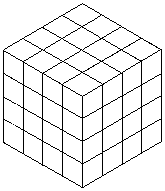
|
Comments Off on Westworld
Saturday, September 24, 2016
From Hermann Weyl's 1952 classic Symmetry —
"Galois' ideas, which for several decades remained
a book with seven seals but later exerted a more
and more profound influence upon the whole
development of mathematics, are contained in
a farewell letter written to a friend on the eve of
his death, which he met in a silly duel at the age of
twenty-one. This letter, if judged by the novelty and
profundity of ideas it contains, is perhaps the most
substantial piece of writing in the whole literature
of mankind."
Some Galois geometry —

See the previous post for more narrative.
Comments Off on The Seven Seals
Wednesday, September 7, 2016
… For those taken aback by the tone of midnight's report
on the death of a 1960's counterculture figure.
See Didion's view of the counterculture in her classic
Slouching Towards Bethlehem .
A search in this journal for Didion + Nihilism yields …
|
From Wallace Stevens: A World of Transforming Shapes, by Alan D. Perlis, Bucknell University Press, 1976, p. 117:
… in 'The Pediment of Appearance,' a slight narrative poem in Transport to Summer …
A group of young men enter some woods 'Hunting for the great ornament, The pediment of appearance.' Though moving through the natural world, the young men seek the artificial, or pure form, believing that in discovering this pediment, this distillation of the real, they will also discover the 'savage transparence,' the rude source of human life. In Stevens's world, such a search is futile, since it is only through observing nature that one reaches beyond it to pure form. As if to demonstrate the degree to which the young men's search is misaligned, Stevens says of them that 'they go crying/The world is myself, life is myself,' believing that what surrounds them is immaterial. Such a proclamation is a cardinal violation of Stevens's principles of the imagination.
|

Comments Off on Related Reading…
Friday, August 12, 2016
Peter Galison, a Harvard professor, is a defender of
the Vienna Circle and the religion of Scientism.
From Galison's “Structure of Crystal, Bucket of Dust,” in
Circles Disturbed: The Interplay of Mathematics and Narrative ,
edited by Apostolos Doxiadis and Barry Mazur, pp. 52-78
(Princeton: Princeton U. Press, 2012) …
Galison's final paragraph —
"Perhaps, then, it should not surprise us too much if,
as Wheeler approaches the beginning-end of all things,
there is a bucket of Borelian dust. Out of this filth,
through the proposition machine of quantum mechanics
comes pregeometry; pregeometry makes geometry;
geometry gives rise to matter and the physical laws
and constants of the universe. At once close to and far
from the crystalline story that Bourbaki invoked,
Wheeler’s genesis puts one in mind of Genesis 3:19:
'In the sweat of thy face shalt thou eat bread, till thou
return unto the ground; for out of it wast thou taken:
for dust thou art, and unto dust shalt thou return.' "
For fans of Scientism who prefer more colorful narratives —

Comments Off on Dustbucket Physics
Monday, July 18, 2016
Ghostwriters!
(This post was suggested by a New Yorker piece online
today about Donald Trump's ghostwriter Tony Schwartz.)

The "ghost writer" link above leads to …

Comments Off on Who You Gonna Call?
Saturday, July 2, 2016
British film director Robin Hardy reportedly
died yesterday. In his memory —

Hardy's film "The Wicker Tree" reportedly opened in the USA on
January 27, 2012. See also narratives in this journal on that date.
Comments Off on But Seriously …
Saturday, June 25, 2016
The title is a reference to the Chicago character named "Four"
in Veronica Roth's Divergent series.
"In July 2014, Roth revealed that she initially wrote
Divergent from Four's point of view . . . ." — Wikipedia
Other Chicago-related stories — "Raiders of the Lost Code"
(on the recent murder-suicide of two Chicago Jungians)
and the following —

See also Jungian narrative art in
https://redice.tv/news/
on-the-nature-of-four-jung-s-quarternity-mandalas-the-stone-and-the-self .
Comments Off on ART WARS: The Story of Four
Friday, June 17, 2016
The Hypertime post from 11 PM yesterday suggests
a review of one sort of narrative sequence —

Here the aleph may be regarded as a sort of
glass slipper (see last midnight's post) found by
Alan Moore. (Moore, mentioned in last night's
Hypertime post, is the author of Lost Girls .)
Comments Off on Hypertime
Tuesday, June 7, 2016
Continues, in memory of chess grandmaster Viktor Korchnoi,
who reportedly died at 85 yesterday in Switzerland —

The coloring of the 4×4 "base" in the above image
suggests St. Bridget's cross.
From this journal on St. Bridget's Day this year —
"Possible title:
A new graphic approach
to an old geometric approach
to a new combinatorial approach
to an old algebraic approach
to M24"
The narrative leap from image to date may be regarded as
an example of "knight's move" thinking.
Comments Off on Art and Space…
Tuesday, May 10, 2016
Comments Off on Game Theory
Thursday, March 31, 2016
The revisiting, below, of an image shown here in part
on Spy Wednesday, 2016, was suggested in part by
a New York Times obituary today for a Nobel-prize
winning Hungarian novelist.

Note the references on the map to
"Devil's Gate" and "Pathfinder."
See also the following from a review of The Pathseeker , a novel
by the Nobel laureate (Imre Kertész), who reportedly died today —
|
… The commissioner is in fact not in search of a path, but rather of traces of the past (more literally the Hungarian title means ‘trace seeker’). His first shock comes at his realization that the site of his sufferings has been converted into a museum, complete with tourists “diligently carrying off the significance of things, crumb by crumb, wearing away a bit of the unspoken importance” (59). He meets not only tourists, however. He also comes across paradoxically “unknown acquaintances who were just as much haunted by a compulsion to revisit,” including a veiled woman who slowly repeats to him the inventory of those she lost: “my father, my younger brother, my fiancé” (79). The commissioner informs her that he has come “to try to redress that injustice” (80). When she asks how, he suddenly finds the words he had sought, “as if he could see them written down: ‘So that I should bear witness to everything I have seen’” (80).
The act of bearing witness, however, proves elusive. In the museum he is compelled to wonder, “What could this collection of junk, so cleverly, indeed all too cleverly disguised as dusty museum material, prove to him, or to anyone else for that matter,” and adds the chilling observation, “Its objects could be brought to life only by being utilized” (71). As he touches the rust-eaten barbed wire fence he thinks, “A person might almost feel in the mood to stop and dutifully muse on this image of decay – were he not aware, of course, that this was precisely the goal; that the play of ephemerality was merely a bait for things” (66). It is this play of ephemerality, the possibility that the past will be consigned to the past, against which the commissioner struggles, yet his struggle is frustrated precisely by the lack of resistance, the indifference of the objects he has come to confront. “What should he cling on to for proof?” he wonders. “What was he to fight with, if they were depriving him of every object of the struggle? Against what was he to try and resist, if nothing was resisting?” (68) He had come with the purpose of “advertis[ing] his superiority, celebrat[ing] the triumph of his existence in front of these mute and powerless things. His groundless disappointment was fed merely by the fact that this festive invitation had received no response. The objects were holding their peace” (109).
In point of fact The Pathseeker makes no specific mention either of the Holocaust or of the concentration camps, yet the admittedly cryptic references to places leave no doubt that this is its subject. Above the gate at the camp the commissioner’s wife reads the phrase, “Jedem das Seine,” to each his due, and one recalls the sign above the entrance to the camp at Buchenwald. Further references to Goethe as well as the Brabag factory, where Kertész himself worked as a prisoner, confirm this. Why this subterfuge on the part of the author? Why a third-person narrative with an unnamed protagonist when so many biographical links tie the author to the story? One cannot help but wonder if Kertész sought specifically to avoid binding his story to particulars in order to maintain the ultimately metaphysical nature of the quest. Like many of Kertész’s works,The Pathseeker is not about the trauma of the Holocaust itself so much as the trauma of survival. The self may survive but the triumph of that survival is chimerical.
Translator Tim Wilkinson made the bold decision, in translating the title of the work, not to resort to the obvious. Rather than simply translate Nyomkereső , an allusion to the Hungarian translation of James Fenimore Cooper’s The Pathfinder , back into English, he preserves an element of the unfamiliar in his title. This tendency marks many of the passages of the English translation, in which Wilkinson has opted to preserve the winding and often frustratingly serpentine nature of many of the sentences of the original instead of rewriting them in sleek, familiar English. . . .
— Thomas Cooper
|
"Sleek, familiar English" —
"Those were the good old days!" — Applegate in "Damn Yankees"
(See previous post.)
Comments Off on Devil’s Gate Revisited
Sunday, January 17, 2016
Some narrative for a ghost writer —

I prefer the following narrative —
Part I: Stevens’s verse from “The Rock” (1954) —
“That in which space itself is contained”
Part II: Mystery Box III: Inside, Outside (2014)
Comments Off on Sunday School
Sunday, January 10, 2016
The title is adapted from that of George Steiner's book
Fields of Force: Fischer and Spassky at Reykjavik
(Published by Viking Adult on June 25, 1974.)
For fields of narrative force, see the previous post.
See as well a memorable review by the late Florence King
of the novel The Eight by Katherine Neville. An illustration
from that review (The New York Times , January 15, 1989) —

Related material: Closing the Circle (Log24, Sept. 24, 2009).
Comments Off on Field of Force
Monday, December 28, 2015
The previous post quoted Holland Cotter's description of
the late Ellsworth Kelly as one who might have admired
"the anonymous role of the Romanesque church artist."
Work of a less anonymous sort was illustrated today by both
The New York Times and The Washington Post —


The Post 's remarks are of particular interest:
|
Philip Kennicott in The Washington Post , Dec. 28, 2015,
on a work by the late Ellsworth Kelly —
“Sculpture for a Large Wall” consisted of 104 anodized aluminum panels, colored red, blue, yellow and black, and laid out on four long rows measuring 65 feet. Each panel seemed different from the next, subtle variations on the parallelogram, and yet together they also suggested a kind of language, or code, as if their shapes, colors and repeating patterns spelled out a basic computer language, or proto-digital message.
The space in between the panels, and the shadows they cast on the wall, were also part of the effect, creating a contrast between the material substance of the art, and the cascading visual and mental ideas it conveyed. The piece was playful, and serious; present and absent; material and imaginary; visually bold and intellectually diaphanous.
Often, with Kelly, you felt as if he offered up some ideal slice of the world, decontextualized almost to the point of absurdity. A single arc sliced out of a circle; a single perfect rectangle; one bold juxtaposition of color or shape. But when he allowed his work to encompass more complexity, to indulge a rhetoric of repetition, rhythmic contrasts, and multiple self-replicating ideas, it began to feel like language, or narrative. And this was always his best mode.
|
Compare and contrast a 2010 work by Josefine Lyche —

Lyche's mirrors-on-the-wall installation is titled
"The 2×2 Case (Diamond Theorem)."
It is based on a smaller illustration of my own.
These variations also, as Kennicott said of Kelly's,
"suggested a kind of language, or code."
This may well be the source of their appeal for Lyche.
For me, however, such suggestiveness is irrelevant to the
significance of the variations in a larger purely geometric
context.
This context is of course quite inaccessible to most art
critics. Steve Martin, however, has a phrase that applies
to both Kelly's and Lyche's installations: "wall power."
See a post of Dec. 15, 2010.
Comments Off on Mirrors, Mirrors, on the Wall
Monday, December 7, 2015
From "AMNESIA: VARIOUS, LUMINOUS, FIXED,"
An exhibition by Joseph Kosuth at
Sprüth Magers Gallery London,
NOVEMBER 26 2014 – FEBRUARY 14 2015 —

This journal, NOVEMBER 26 2014 –
This journal, FEBRUARY 14 2015 —

Comments Off on Wittgenstein Illustrated
Thursday, July 2, 2015
(Continued)
Beloved professor dies unexpectedly
"Wesson also said Cottier had 'an encyclopedic
knowledge of everything historical and archaeological,'
and that he lectured straight from memory using
storytelling as a teaching method.
'He was absolutely the best lecturer that I've ever had,
spellbinding,' Wesson said. 'He would tell the most
amazing narratives, and the one thing that I could say,
that I've said to a couple of people today, is he was the
closest thing to a real Indiana Jones that there ever will be.
He lived an extraordinary life, just absolutely unusual
in every way and was unafraid of anything. He was the
most fearless person that I've ever met.'"
See also Pawn Sacrifice (June 28, 2015).
Comments Off on The Story Theory of Truth
Thursday, May 7, 2015
Thursday, April 16, 2015
"Celebrate National Library Week 2015 (April 12-18, 2015)
with the theme "Unlimited possibilities @ your library®."
See also Library of Hell.
A page from Princeton University Press on March 18, 2012:

… "mathematics and narrative…." (top of page xvii).
I prefer the interplay of Euclidean and Galois mathematics.
Comments Off on National Library Week
Monday, April 13, 2015
(A sequel to yesterday's Orthodox Easter posts)
This morning's Google News —

The New York Times on the late Günter Grass —
"Many of Mr. Grass’s books are phantasmagorical
mixtures of fact and fantasy, some of them inviting
comparison with the Latin American style known as
magical realism. His own name for this style was
'broadened reality.'"
From p. xii of the 2005 second edition of a book discussed
in yesterday's Orthodox Easter posts —
(Click image to enlarge.)
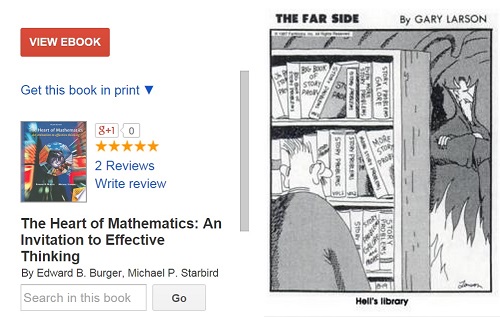
Early editions of The Heart of Mathematics include
Gary Larson's legendary Hell's Library "Far Side" cartoon.
Books in Hell's Library include Big Book of Story Problems ,
More Story Problems , and Even More Story Problems .
— Adapted from a review of the 2000 first edition
See also Mathematics and Narrative in this journal.
Comments Off on Unorthodox Easter
Tuesday, April 7, 2015
Seven years ago in this journal —
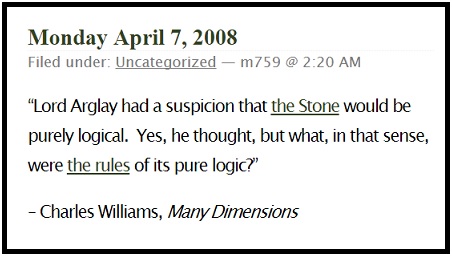
The above links: the Stone, the rules.
Comments Off on Logic
Wednesday, February 18, 2015
"I am trying to introduce a narrative,
something magical and seductive…."
— Oslo artist Josefine Lyche, translated
from the Norwegian by Google
Perhaps something like Arcade Fire or
Taylor Swift? (Click links for related posts.)
Comments Off on Magical and Seductive
Thursday, February 12, 2015
Continued from yesterday.
The passage on Claude Chevalley quoted here
yesterday in the post Dead Reckoning was, it turns out,
also quoted by Peter Galison in his essay "Structure of Crystal,
Bucket of Dust" in Circles Disturbed: The Interplay of
Mathematics and Narrative (Princeton University Press, 2012,
ed. by Apostolos Doxiadis and Barry Mazur).
Galison gives a reference to his source:
"From 'Claude Chevalley Described by His Daughter (1988),'
in Michèle Chouchan, Nicolas Bourbaki: Faits et légendes
(Paris: Éditions du Choix, 1995), 36–40, translated and cited
in Marjorie Senechal, 'The Continuing Silence of Bourbaki:
An Interview with Pierre Cartier, June 18, 1997,'
Mathematical Intelligencer 1 (1998): 22–28."
Galison's essay compares Chevalley with the physicist
John Archibald Wheeler. His final paragraph —
"Perhaps, then, it should not surprise us too much if,
as Wheeler approaches the beginning-end of all things,
there is a bucket of Borelian dust. Out of this filth,
through the proposition machine of quantum mechanics
comes pregeometry; pregeometry makes geometry;
geometry gives rise to matter and the physical laws
and constants of the universe. At once close to and far
from the crystalline story that Bourbaki invoked,
Wheeler’s genesis puts one in mind of Genesis 3:19:
'In the sweat of thy face shalt thou eat bread, till thou
return unto the ground; for out of it wast thou taken:
for dust thou art, and unto dust shalt thou return.'"
See also posts tagged Wheeler.
Comments Off on Dead Reckoning
Friday, January 9, 2015
(An episode of Mathematics and Narrative .)
Mathematician Peter J. Cameron this morning
on a Paris anthropological exhibition subtitled
Révélation d’un temps sans fin —
"I was reminded of Herbert Read’s
novel The Green Child ."
Related recent posts from this journal:
Seal for the Seventh, Forthright, and Fourth Right.
A passage from The Green Child :
"He watched over her until he too began to feel
overpowered by a desire to sleep. He therefore
got out on to the ledge of the trough and pulled
the Green Child after him. The rock there was
warm, smooth as jade to the flesh. They lay there
and sank into a profound slumber."
Sweet dreams, Mr. Taylor.
Green Child on the Rocks —

Comments Off on Plan 9 Continues
Saturday, December 20, 2014
The President of the United States
on the Sony hacking
in his Dec. 19 press conference:
"But let’s talk of the specifics of what we now know.
The FBI announced today and we can confirm that
North Korea engaged in this attack. I think it says
something interesting about North Korea that they
decided to have the state mount an all-out assault
on a movie studio because of a satirical movie…."
This post was suggested in part by the contemptibly
misleading remarks of Carl Sagan in his "Cosmos"
TV series (see yesterday's Colorful Tale) and by the
following remarks in a Presentation Zen piece dated
March 11, 2014, "More Storytelling Lessons from 'Cosmos',"
praising Sagan's vulgarizations —
"Good storytelling causes the audience to ask questions
as your narrative progresses. As the storyteller you can
ask questions directly, but often a more interesting approach
is to present the material in a way that triggers the audience
to come up with the questions themselves. And yet we must
not be afraid to leave some (many?) questions unanswered.
When we think of a story we may think of clear conclusions
and neat, clear endings, but reality can be quite a bit more
complicated than that."
Comments Off on Gullible’s Travels
Monday, December 15, 2014
Today’s 8:01 PM post quoted Husserl on
the perception of the cube.
Another approach to perception of the cube,
from Narrative Metaphysics on St. Lucia’s Day —
From today’s 11:29 AM post —
John Burt Foster Jr. in Nabokov’s Art of Memory and
European Modernism (Princeton U. Press, 1993, p. 224) —
At the time of The Waste Land , in a comment on
Joyce’s Ulysses that influenced many later definitions
of modernism in the English-speaking world, Eliot
announced, “instead of narrative method, we may
now use the mythical method.”13
For some illuminating remarks on a mythical approach
to perception of the cube, see Gareth Knight on Schicksalstag 2012.
Comments Off on Mythic Metaphysics
John Burt Foster Jr. in Nabokov’s Art of Memory and
European Modernism (Princeton U. Press, 1993, p. 224) —
At the time of The Waste Land , in a comment on
Joyce’s Ulysses that influenced many later definitions
of modernism in the English-speaking world, Eliot
announced, “instead of narrative method, we may
now use the mythical method.”13
May we? … Further details —
|
From
T. S. Eliot, “‘Ulysses,’ Order and Myth,”
in The Dial , LXXV, No. 5 (Nov. 1923),
pp. 480-83,
the last two paragraphs:
It is here that Mr Joyce’s parallel use of the Odyssey has a great importance. It has the importance of a scientific discovery. No one else has built a novel upon such a foundation before: it has never before been necessary. I am not begging the question in calling Ulysses a novel; and if you call it an epic it will not matter. If it is not a novel, that is simply because the novel is a form which will no longer serve; it is because the novel, instead of being a form, was simply the expression of an age which had not sufficiently lost all form to feel the need of something stricter. Mr Joyce has written one novel – the Portrait ; Mr Wyndham Lewis has written one novel – Tarr . I do not suppose that either of them will ever write another “novel.” The novel ended with Flaubert and with James. It is, I think, because Mr Joyce and Mr Lewis, being “in advance” of their time, felt a conscious or probably unconscious dissatisfaction with the form, that their novels are more formless than those of a dozen clever writers who are unaware of its obsolescence.
In using the myth, in manipulating a continuous parallel between contemporaneity and antiquity, Mr Joyce is pursuing a method which others must pursue after him. They will not be imitators, any more than the scientist who uses the discoveries of an Einstein in pursuing his own, independent, further investigations. It is simply a way of controlling, of ordering, of giving a shape and a significance to the immense panorama of futility and anarchy which is contemporary history. It is a method already adumbrated by Mr Yeats, and of the need for which I believe Mr Yeats to have been the first contemporary to be conscious. It is a method for which the horoscope is auspicious. Psychology (such as it is, and whether our reaction to it be comic or serious), ethnology, and <i”>The Golden Bough have concurred to make possible what was impossible even a few years ago. Instead of narrative method, we may now use the mythical method. It is, I seriously believe, a step towards making the modern world possible for art, toward that order and form which Mr Aldington so earnestly desires. And only those who have won their own discipline in secret and without aid, in a world which offers very little assistance to that end, can be of any use in furthering this advance. </i”>
|
Comments Off on May We?
Saturday, December 13, 2014
The title refers to remarks linked to this afternoon :
"An ingenious story line serves to convey
the mysteriousness of destiny, the 'grim pen'
of fate that encloses Hazel Shade."
— John Burt Foster Jr. on page 224 of
Nabokov's Art of Memory and European Modernism
(Princeton University Press, 1993)

Vide a relevant page on Wallace Stevens.
Comments Off on Grim Pen
For St. Lucia's Day —
A book that links the title of today's previous post,
Narrative Metaphysics, with Nabokov's "combinational delight."
Comments Off on Combinational Delight
Sunday, November 9, 2014
The Ideas
“We tell ourselves stories in order to live….
We interpret what we see, select the most workable
of multiple choices. We live entirely, especially if we
are writers, by the imposition of a narrative line upon
disparate images, by the ‘ideas’ with which we have
learned to freeze the shifting phantasmagoria
which is our actual experience.” — Joan Didion |
See Didion and the I Ching and posts tagged Plato in China .
Comments Off on Sermon
Friday, October 17, 2014
On Walter Isaacson’s The Innovators :
“Yet as the book’s five hundred–plus pages unwind, Isaacson interrupts himself to present small bromides about what it means to innovate and what we might learn from these innovators, our presumed betters. “Innovation requires articulation,” he tells us, after explaining how the main strength of Grace Hopper, a trailblazing computer scientist for the US Navy, was her ability to speak in the languages of mathematicians, engineers, programmers, and soldiers alike. ‘One useful leadership talent is knowing when to push ahead against doubters and when to heed them,’ he offers later.
The book is peppered with these kinds of passages, which often intrude on the narrative, depriving us of moments of real emotional power.”
— Jacob Silverman in Bookforum , Sept/Oct/Nov 2014
From Isaacson’s book:

Related material:
In memory of T. S. Eliot…

… and in memory of Stanley Chase, producer of Colossus: The Forbin Project
and of Threepenny Opera :
Ninefold square from Colossus
(“There is another system”) —

Fourfold square introducing Brecht
in Dreigroschen Trifft Vierfarben —

Comments Off on Raiders of the Inarticulate
Wednesday, October 15, 2014
For Dorothy Maharam Stone, mathematician, who reportedly
died on Sept. 27, 2014 (Gwyneth Paltrow’s birthday):
“When I die…. I want it to be Hollywood all the way.
I don’t want some rabbi rambling on; I want
Meryl Streep crying, in five different accents….”
— Joan Rivers
How about Meryl Streep as Ethel Greenglass Rosenberg
saying Kaddish in Angels in America ?

Comments Off on Look Homeward, Dorothy
Tuesday, October 7, 2014
Or: Phantasmagoria Meets Pandemonium
Part I: Phantasmagoria
Rebecca Goldstein on first encountering Plato —
“I was reading Durant’s section on Plato, struggling to understand
his theory of the ideal Forms that lay in inviolable perfection
out beyond the phantasmagoria. (That was the first, and I think
the last, time that I encountered that word.)” |
Screenwriter Joan Didion —
“We tell ourselves stories in order to live….We interpret
what we see, select the most workable of multiple choices.
We live entirely, especially if we are writers, by the imposition
of a narrative line upon disparate images, by the ‘ideas’
with which we have learned to freeze the shifting phantasmagoria
which is our actual experience.” |
Part II: Pandemonium
Terry Teachout in Commentary on Oct. 1, 2014:
“When making art or writing about it, the aesthete
tries never to moralize. Nor will he look with favor
upon artists who do so, no matter whether their
particular brand of moralizing is religious or secular.
But he can and must be fully, intensely alive to the
moral force of art whose creators aspire merely to
make the world around us more beautiful, and in
so doing to pierce the veil of the visible and give us
a glimpse of the permanently true. That is his job:
to help make sense of the pandemonium amid which
we live.”
Rivka Galchen in The New York Times Sunday Book Review
issue of October 5, 2014 (online Sept. 30):
“The story describes honestly something that is,
which is very different from proposing what ought to be.”
See also Pandemonium in this journal.
Comments Off on Principles of Aesthetics
Thursday, September 25, 2014
Recommended reading for Josefine Lyche:

See also Ayn Sof (Jan. 7, 2011).
Comments Off on Theology and Art
Wednesday, September 24, 2014
“We tell ourselves stories in order to live.
The princess is caged in the consulate.
The man with the candy will lead the children into the sea.
The naked woman on the ledge outside the window
on the sixteenth floor is a victim of accidie, or
the naked woman is an exhibitionist, and it would be
‘interesting’ to know which. We tell ourselves that it makes
some difference whether the naked woman is about to
commit a mortal sin or is about to register a political protest
or is about to be, the Aristophanic view, snatched back to the
human condition by the fireman in priest’s clothing just visible
in the window behind her, the one smiling at the telephoto lens.
We look for the sermon in the suicide, for the social or moral
lesson in the murder of five. We interpret what we see, select
the most workable of the multiple choices. We live entirely,
especially if we are writers, by the imposition of a narrative line
upon disparate images, by the ‘ideas’ with which we have learned
to freeze the shifting phantasmagoria which is our actual
experience.”
― Joan Didion
This evening’s New York Lottery: 659 and 7326.
Comments Off on Ideas
Tuesday, August 5, 2014
|
"We tell ourselves stories in order to live…. We interpret what we see, select the most workable of multiple choices. We live entirely, especially if we are writers, by the imposition of a narrative line upon disparate images, by the 'ideas' with which we have learned to freeze the shifting phantasmagoria which is our actual experience."
— Joan Didion
|
See also a post from May 4, 2011 (the date, according to a Google
search, of untitled notes regarding a matrix called Omega).
Comments Off on The Omega Story
Monday, June 23, 2014
Or: Mathematics and Narrative, Continued
In memory of a Stanford Arabist who reportedly died yesterday:

Another dream palace, from science fiction:

From Catherine Asaro’s The Spacetime Pool :
|
She couldn’t believe him. That he sounded sane made none of this more plausible. “And you have no idea how this gate works?” she challenged.
His gaze flashed. “Of course I do. It’s a branch. From here to your mountains.”
“A tree, you mean?”
“No. A branch cut to another page. Your universe is one sheet, mine is another.”
She gaped at him. “Do you mean a Riemann sheet? A branch cut from one Riemann sheet to another?”
“That’s right.” He hesitated. “You know these words?”
She laughed unsteadily. “It’s nonsense. Not the sheets, I mean, but they’re just mathematical constructs! They don’t actually exist. You can’t physically go through a branch cut any more than you could step into a square root sign.”
He was watching her with an expression that mirrored how she had felt when he told her about his prophecy. “I have no idea what you’re talking about.”
“Complex variable analysis.” She felt as if she were in a play where she only knew part of the script. “A branch cut is like a slit in a sheet of paper. It opens onto another sheet. I suppose you could say the sheets are alternate universes. But they aren’t real.”
“They seem quite real,” he said. |
Related material: From Sunday, the day of the Stanford Arabist’s death,
a quotation from a 2013 book on “the rise of complex function theory.”
Comments Off on Dream Palace
Monday, May 26, 2014
… Continues.
A post by Margaret Soltan this morning:

Links (in blue) from the above post:
Cane and Mondo Cane.
Bagger Vance — “Time for you to see the field.”
From Pictures for Kurosawa (Sept. 6, 2003) —
“As these flowing rivers that go towards the ocean,
when they have reached the ocean, sink into it,
their name and form are broken, and people speak of
the ocean only, exactly thus these sixteen parts
of the spectator that go towards the person (purusha),
when they have reached the person, sink into him,
their name and form are broken, and people speak of
the person only, and he becomes without parts and
immortal. On this there is this verse:
‘That person who is to be known, he in whom these parts
rest, like spokes in the nave of a wheel, you know him,
lest death should hurt you.’ “
— Prasna Upanishad
Related material — Heaven’s Gate images from Xmas 2012:

“This could be heaven or this could be hell.” — Hotel California
Those who prefer mathematics to narrative may consult Root Circle.
Comments Off on Springtime for Vishnu
Thursday, May 15, 2014

On Edward Frenkel:
"Math is, for him, 'a narrative' of human endeavor
that shares much with art, music and religion.
For instance, he describes new mathematical insights
as 'revelations,' and the utterly unchanging truths of
mathematical ideas are 'nothing short of a miracle.'"
Uh-huh.
Comments Off on Mathematics as Religion
Monday, March 31, 2014
On The Blazing World , a new novel —
“Hustvedt uses fragment-stories, frame narratives, and unreliable
narrators to talk about the ways in which brilliant women across
history have been silenced, forgotten, and appropriated by men.
This is a narrative suspicious of narratives, a story that
demonstrates how damaging stories can be.”
— Review by Amal El-Mohtar
The protagonist of Hustvedt’s novel is named Harriet Burden.
A midrash for Darren Aronofsky, director of The Fountain* and Noah—
Part I: The Burden of Proof —

Part II: The Story of Noam —

* See The Fountain in “The Story Theory of Truth,” Columbus Day, 2013
Comments Off on The Story of Noam
“…what he was trying to get across was not that he was the Soldier of a Power that was fighting across all of time to change history, but simply that we men were creatures with imaginations and it was our highest duty to try to tell what it was really like to live in other times and places and bodies. Once he said to me, ‘The growth of consciousness is everything… the seed of awareness sending its roots across space and time. But it can grow in so many ways, spinning its web from mind to mind like the spider or burrowing into the unconscious darkness like the snake. The biggest wars are the wars of thought.'”
— Fritz Leiber, “The Oldest Soldier” (1960)

“And that’s the snake.” — Jill Clayburgh in “It’s My Turn” (1980)

Backstory — “For Daedalus,” May 26, 2009.
For a more up-to-date look at Burroway, see a
Chicago Tribune story of March 21, 2014.
Comments Off on For Women’s History Month
Thursday, March 27, 2014
The following is from a web page by
Andreas Schöter, developer of The Symbol Game.
Building the Narrative
The game can simply be played as a competitive board game,
simply trying to accumulate the most points. However,
to play this way is to miss the main purpose of the Symbol Game.
The author’s page on the game itself —

(This post was suggested by this afternoon’s post Diamond Space.)
Comments Off on Symbol Game
Wednesday, March 26, 2014
(Continued)
The front page of The New York Times Book Review
for next Sunday (March 30, 2014) is devoted to a
review of Siri Hustvedt’s new novel The Blazing World .
See two posts from St. Patrick’s day: Her and Narratives.
The review’s author is Fernanda Eberstadt.
The review is titled “Outsider Art.”
See also that phrase in this journal.
Comments Off on Her
Friday, February 28, 2014
"Once a verbal structure is read, and reread
often enough to be possessed, it 'freezes.'
It turns into a unity in which all parts exist at
once, without regard to the specific movement
of the narrative. We may compare it to the study
of a music score, where we can turn to any
part without regard to sequential performance."
— Northrop Frye in The Great Code

Gardner reportedly died at 65 on February 19.
A post linked to here on that date suggests some
musical remarks.
Comments Off on Score
|
From Northrop Frye's The Great Code: The Bible and Literature , Ch. 3: Metaphor I —
"In the preceding chapter we considered words in sequence, where they form narratives and provide the basis for a literary theory of myth. Reading words in sequence, however, is the first of two critical operations. Once a verbal structure is read, and reread often enough to be possessed, it 'freezes.' It turns into a unity in which all parts exist at once, without regard to the specific movement of the narrative. We may compare it to the study of a music score, where we can turn to any part without regard to sequential performance. The term 'structure,' which we have used so often, is a metaphor from architecture, and may be misleading when we are speaking of narrative, which is not a simultaneous structure but a movement in time. The term 'structure' comes into its proper context in the second stage, which is where all discussion of 'spatial form' and kindred critical topics take their origin."
|
Related material:
|
"The Great Code does not end with a triumphant conclusion or the apocalypse that readers may feel is owed them or even with a clear summary of Frye’s position, but instead trails off with a series of verbal winks and nudges. This is not so great a fault as it would be in another book, because long before this it has been obvious that the forward motion of Frye’s exposition was illusory, and that in fact the book was devoted to a constant re-examination of the same basic data from various closely related perspectives: in short, the method of the kaleidoscope. Each shake of the machine produces a new symmetry, each symmetry as beautiful as the last, and none of them in any sense exclusive of the others. And there is always room for one more shake."
— Charles Wheeler, "Professor Frye and the Bible," South Atlantic Quarterly 82 (Spring 1983), pp. 154-164, reprinted in a collection of reviews of the book.
|
For code in a different sense, but related to the first passage above,
see Diamond Theory Roullete, a webpage by Radamés Ajna.
For "the method of the kaleidoscope" mentioned in the second
passage above, see both the Ajna page and a webpage of my own,
Kaleidoscope Puzzle.
Saturday, February 22, 2014
Some narrative notes in memory of a
Bowling Green State University math professor
who reportedly died at 72 on Feb. 13—
That date in this journal and Green Fields.
See also Nine is a Vine.
Those who prefer mathematics to narrative may
also prefer to read, instead of the notes above,
some material on the dead professor's specialty,
Diophantine equations. Recommended:
Mordell on Lang and Lang on Mordell as well as
Lang's article titled
"Mordell's Review, Siegel's Letter to Mordell,
Diophantine Geometry, and 20th Century Mathematics."
Some background —

Comments Off on Green Fields
Friday, February 21, 2014
One way of interpreting the symbol 
at the end of yesterday's post is via
the phrase "necessary possibility."
See that phrase in (for instance) a post
of July 24, 2013, The Broken Tablet .
The Tablet post may be viewed in light
of a Tom Wolfe passage quoted here on
the preceding day, July 23, 2013—

On that day (July 23) another weblog had
a post titled
Wallace Stevens: Night's Hymn of the Rock.
Some related narrative —

I prefer the following narrative —
Part I: Stevens's verse from "The Rock" (1954) —
"That in which space itself is contained"
Part II: Mystery Box III: Inside, Outside (2014)
Comments Off on Night’s Hymn of the Rock
Monday, December 30, 2013
A link to a Nov. 22 post on Arcade Fire was added today
to yesterday's "Dating an OS" post.
That Nov. 22 post suggests a review related to a new film —
"If the spy wars of the later 20th century were fought
in 'a wilderness of mirrors,' beset by paradox and
moral uncertainty— evil done in the name of good—
then John le Carré, or, rather, the narrative voice that
went by the name John le Carré, was the perfect
choice to polish those mirrors. It was the voice of the
urbane, upper-class Englishman: courteous, opaque
and chilly, with a ruthless, penetrative intellect and
razor wit for the delivery of its insights."
— Alan Furst in The New York Times Sunday
Book Review on October 12, 2008
For other material on mirrors, see all posts tagged Arcade Fire.
Comments Off on A Wilderness of Mirrors
Sunday, November 3, 2013
The title, that of a novel by Arthur Koestler,
has appeared before in this journal.
The title was quoted in a Log24 note of
May 29, 2002 (G.K. Chesterton's birthday).
The link in Saturday evening's post to a Chesterton
essay suggested a further search that yielded
the following quotation—
Then silence sank. And slowly
Arose the sea-land lord
Like some vast beast for mystery,
He filled the room and porch and sky,
And from a cobwebbed nail on high
Unhooked his heavy sword.
— G. K. Chesterton,
The Ballad of the White Horse
This, together with some Log24 remarks
from 2004, suggests two images—
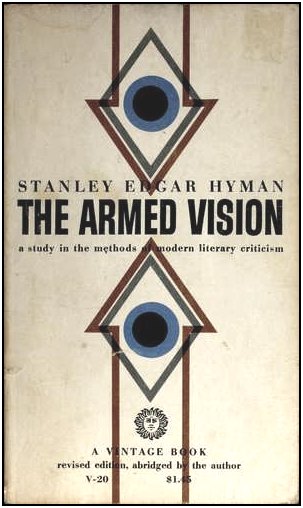
Above: A 1955 cover design by Robert Flynn.
The arrow theme also appears in a figure from
John Sealander's Road to Nowhere in the 2004
remarks:

The remarks quoting the Sealander image, from
March 5, 2004, were on mathematics and narrative.
Related material from a year later:
See an announcement, saved from March 16, 2005,
of a conference on mathematics and narrative that
was held in July 2005. Some context: Koestler's novel.
Comments Off on The Call Girls
Tuesday, September 24, 2013
For the late Carolyn Cassady, once a wife of Neal Cassady
(Dean Moriarty of Jack Kerouac's classic novel On the Road ).
She reportedly died at 90 in England on Friday, September 20,
2013.
From a post in this journal on the night of September 20-21,
with waning Harvest Moon:

Click on "Aooo" for some related posts, tagged "Howl."
Comments Off on Sleep Tale
Thursday, August 29, 2013
(Mathematics and Narrative, continued from May 9, 2013)


See also Scriba's The Concept of Number and,
from the date of his death, The Zero Theorem.
Comments Off on An End in Itself
Monday, August 26, 2013
From the weblog of Dr. David Justice today :
C.S. Lewis somewhere (in time, in retirement, I might recover
the passage) surveys the spectrum of plot-outlines, and notes
that that of Orpheus retains its power to spellbind, even in a
bare-bones form, whereas that of almost all worthy modern novels,
become as dust upon such summary.
We venture now upon that territory where words fail ….
Related material :
C. S. Lewis on Orpheus (click to enlarge) —

Lewis, according to Justice, "surveys the spectrum of plot-outlines."
A related image (see, too, today's previous post) —

C. S. Lewis on myth —
"The stories I am thinking of always have a very simple narrative shape—
a satisfactory and inevitable shape, like a good vase or a tulip."
Conceptual Art
For concepts of prism, spectrum, and tulip combined, see Sicilian Reflections.
"For every kind of vampire, there is a kind of cross."
— Gravity's Rainbow
Comments Off on Spectrum
Saturday, August 24, 2013
For the late Julie Harris —
By slow and carefully modulated steps Bradford's narrative
has brought his community of separatists to the place he
calls Cape Harbor… where, face-to-face with the bleak
and wintry reduction that is his image for American space,
he finds himself stopped, able to do nothing but come to
an astonished pause. The final step, that of imaginative
crossing into the land that lies before them, remains
beyond the power of narrative to take. Narrative falters, and
finding his journey advanced to an "odd Fork in Being's Road"
and himself nothing so much as an "empty spirit / In vacant
space" (to adopt apt phrases from Dickinson and Stevens…),
Bradford requires the sublime if he is to continue moving
forward: separation becomes exaltation as it becomes
manifest that only an influx of "the Spirit of God and His
grace" can have permitted the community to survive its
passage to the limit depicted.
— David Laurence, "William Bradford's American Sublime,"
PMLA , Vol. 102, No. 1, 1987, pp. 55-65
Comments Off on Being’s Road
Monday, May 20, 2013
This post is continued from "Church Narrative," a Log24 post of November 17, 2010.
In memory of Ray Manzarek, remarks from a different weblog on that same date:
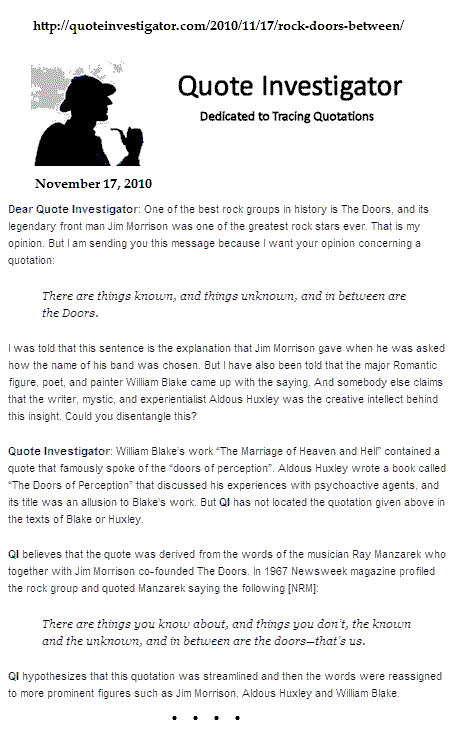
Comments Off on Church Logic
Saturday, May 18, 2013
A followup to last midnight's Black Hole Revisited .

See also Victor Turner on liminality, together with Paul Goodman
on public squares, in a post of May 8, 2007.
Related material: Midnight in Dostoevsky (St. Andrew's Day, 2009).
Comments Off on Midnight in Bakhtin
Tuesday, May 14, 2013
Comments Off on Snakes on a Plane
Sunday, April 28, 2013
Saturday, April 13, 2013
The title is that of a talk (see video) given by
George Dyson at a Princeton land preservation trust,
reportedly on March 21, 2013. The talk's subtitle was
"Oswald Veblen and the Six-hundred-acre Woods."
Meanwhile…
Related material for those who prefer narrative
to mathematics:
Related material for those who prefer mathematics
to narrative:

What the Omen narrative above and the mathematics of Veblen
have in common is the number 6. Veblen, who came to
Princeton in 1905 and later helped establish the Institute,
wrote extensively on projective geometry. As the British
geometer H. F. Baker pointed out, 6 is a rather important number
in that discipline. For the connection of 6 to the Göpel tetrads
figure above from March 21, see a note from May 1986.
See also last night's Veblen and Young in Light of Galois.
"There is such a thing as a tesseract." — Madeleine L'Engle
Comments Off on Princeton’s Christopher Robin
Saturday, March 16, 2013
For readers of The Daily Princetonian :

(From a site advertised in the
Princetonian on March 11, 2013)
For readers of The Harvard Crimson :

For some background, see Crimson Easter Egg and the Diamond 16 Puzzle.
For some (very loosely) related narrative, see Crosswicks in this journal
and the Crosswicks Curse in a new novel by Joyce Carol Oates.
"There is such a thing as a tesseract."
— Crosswicks author Madeleine L'Engle
Comments Off on Puzzles
Sunday, February 3, 2013
Yesterday's 11 AM post Mad Day concluded
with a link to a 2001 American Mathematical Society
article by Pierre Cartier that sums up the religion and
politics of many mathematicians…
"Here ends the infancy narrative of the gospel…."
"… while Simone Weil's Catholicism was violently
anti-Semitic (in 1942!), Grothendieck's Buddhism
bears a strong resemblance to the practices of
his Hasidic ancestors."
See also Simone Weil in this journal.
Note esp. a post of April 6, 2004 that provides
a different way of viewing Derrida's notion of
inscription .
Comments Off on The Gospel According to Cartier
Saturday, January 26, 2013

Excerpt from an essay cached nine years ago:
"The current dominant conceptual framework
which pictures the self as an inner entity
is slowly breaking up. And I am convinced that
some, if not all, of the approaches to the self
sketched here will form the basis for a new
conceptual framework…."
Context for the essay:
A journal issue titled "The Opening of Narrative Space" (pdf, 475 KB)
For one sort of narrative space, see Giordano Bruno in this journal.
See also Nine Years.
Comments Off on Nine Years
Saturday, January 5, 2013
The finite (i.e., Galois) field GF(16),
according to J. J. Seidel in 1974—

The same field according to Steven H. Cullinane in 1986,
in its guise as the affine 4-space over GF(2)—

The same field, again disguised as an affine 4-space,
according to John H. Conway and N.J.A. Sloane in
Sphere Packings, Lattices, and Groups , first published in 1988—

The above figure by Conway and Sloane summarizes, using
a 4×4 array, the additive vector-space structure of the finite
field GF(16).
This structure embodies what in Euclidean space is called
the parallelogram rule for vector addition—

(Thanks to June Lester for the 3D (uvw) part of the above figure.)
For the transition from this colored Euclidean hypercube
(used above to illustrate the parallelogram rule) to the
4×4 Galois space (illustrated by Cullinane in 1979 and
Conway and Sloane in 1988— or later… I do not have
their book’s first edition), see Diamond Theory in 1937,
Vertex Adjacency in a Tesseract and in a 4×4 Array,
Spaces as Hypercubes, and The Galois Tesseract.
For some related narrative, see tesseract in this journal.
(This post has been added to finitegeometry.org.)
Update of August 9, 2013—
Coordinates for hypercube vertices derived from the
parallelogram rule in four dimensions were better
illustrated by Jürgen Köller in a web page archived in 2002.
Update of August 13, 2013—
The four basis vectors in the 2002 Köller hypercube figure
are also visible at the bottom of the hypercube figure on
page 7 of “Diamond Theory,” excerpts from a 1976 preprint
in Computer Graphics and Art , Vol. 2, No. 1, February 1977.
A predecessor: Coxeter’s 1950 hypercube figure from
“Self-Dual Configurations and Regular Graphs.”
Comments Off on Vector Addition in a Finite Field
Monday, November 5, 2012
Some webpages at finitegeometry.org discuss
group actions on Sylvester’s duads and synthemes.
Those pages are based on the square model of
PG(3,2) described in the 1980’s by Steven H. Cullinane.
A rival tetrahedral model of PG(3,2) was described
in the 1990’s by Burkard Polster.
Polster’s tetrahedral model appears, notably, in
a Mathematics Magazine article from April 2009—

Click for a pdf of the article.
Related material:
“The Religion of Cubism” (May 9, 2003) and “Art and Lies”
(Nov. 16, 2008).
This post was suggested by following the link in yesterday’s
Sunday School post to High White Noon, and the link from
there to A Study in Art Education, which mentions the date of
Rudolf Arnheim‘s death, June 9, 2007. This journal
on that date—
Cryptology

— The Delphic Corporation
The Fink-Guy article was announced in a Mathematical
Association of America newsletter dated April 15, 2009.
Those who prefer narrative to mathematics may consult
a Log24 post from a few days earlier, “Where Entertainment is God”
(April 12, 2009), and, for some backstory, The Judas Seat
(February 16, 2007).
Comments Off on Sitting Specially
Thursday, October 25, 2012
Mathematics and Narrative continues…

Steiner's version of "classical functional analysis"—

"Mein Führer… Steiner…"

* See the story by Kilgore Trout. See also On Linguistic Creation,
The Matrix of Abraham, and The Thoreau Foundation.
Comments Off on Bunker Bingo*
Tuesday, October 16, 2012
Last Wednesday's 11 PM post mentioned the
adjacency-isomorphism relating the 4-dimensional
hypercube over the 2-element Galois field GF(2) to
the 4×4 array made up of 16 square cells, with
opposite edges of the 4×4 array identified.
A web page illustrates this property with diagrams that
enjoy the Karnaugh property— adjacent vertices, or cells,
differ in exactly one coordinate. A brief paper by two German
authors relates the Karnaugh property to the construction
of a magic square like that of Dürer (see last Wednesday).
In a similar way (search the Web for Karnaugh + cube ),
vertex adjacency in the 6-dimensional hypercube over GF(2)
is isomorphic to cell adjacency in the 4x4x4 cube, with
opposite faces of the 4x4x4 cube identified.
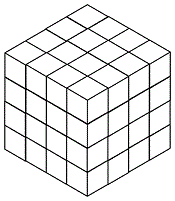
The above cube may be used to illustrate some properties
of the 64-point Galois 6-space that are more advanced
than those studied by enthusiasts of "magic" squares
and cubes.
See
Those who prefer narrative to mathematics may
consult posts in this journal containing the word "Cuber."
Comments Off on Cube Review
Wednesday, September 19, 2012
Today's previous post, "For Odin's Day," discussed
a mathematical object, the tesseract, from a strictly
narrative point of view.
In honor of George Balanchine, Odin might yield the
floor this evening to Apollo.
From a piece in today's online New York Times titled
"How a God Finds Art (the Abridged Version)"—
"… the newness at the heart of this story,
in which art is happening for the first time…."
Some related art—

and, more recently—

This more recent figure is from Ian Stewart's 1996 revision
of a 1941 classic, What Is Mathematics? , by Richard Courant
and Herbert Robbins.
Apollo might discuss with Socrates how the confused slave boy
of Plato's Meno would react to Stewart's remark that
"The number of copies required to double an
object's size depends on its dimension."
Apollo might also note an application of Socrates' Meno diagram
to the tesseract of this afternoon's Odin post—
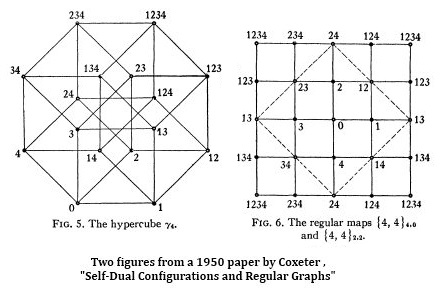 .
.
Comments Off on Art Wars (continued)
« Newer Posts —
Older Posts »











































































































































































